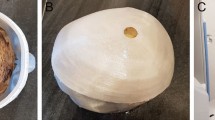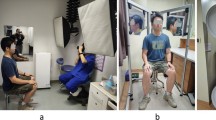Abstract
A computer modeling system for facial reconstruction has been developed that employs a touch-based application to create anatomically accurate facial models focusing on skeletal detail. This article discusses the advantages and disadvantages of the system and illustrates its accuracy and reliability with a blind study using computed tomography (CT) data of living individuals. Three-dimensional models of the skulls of two white North American adults (one male, one female) were imported into the computer system. Facial reconstructions were produced by two practitioners following the Manchester method. Two posters were produced, each including a face pool of five surface model images and the facial reconstruction. The face pool related to the sex, age, and ethnic group of the target individual and included the surface model image of the target individual. Fifty-two volunteers were asked to choose the face from the face pool that most resembled each reconstruction. Both reconstructions received majority percentage hit rates that were at least 50% greater than any other face in the pool. The combined percentage hit rate was 50% above chance (70%). A quantitative comparison of the facial morphology between the facial reconstructions and the CT scan models of the subjects was carried out using Rapidform™ 2004 PP2-RF4. The majority of the surfaces of the facial reconstructions showed less than 2.5 mm error and 90% of the male face and 75% of the female face showed less than 5 mm error. Many of the differences between the facial reconstructions and the facial scans were probably the result of positional effects caused during the CT scanning procedure, especially on the female subject who had a fatter face than the male subject. The areas of most facial reconstruction error were at the ears and nasal tip.
Similar content being viewed by others
References
Taylor K. Forensic Art and Illustration. Boca Raton, RL; CRC Press, 2001.
Gatliff BP. Facial sculpture on the skull for identification. Am J Forensic Med Pathol 1984;5:327–332.
Gerasimov MM. The Face Finder: New York: Lippincott, 1971.
Prag J, Neave RAH. Making Faces. London: British Museum Press, 1997.
Moss JP, Linney AD, Grindrod SR, Arridge SR, Clifton JS. 3-dimensional visualisation of the face and skull using computerised tomography and laser scanning techniques. Eur J Orthod 1984;9:247–253.
Kahler K, Haber J, Seidel HP. Reanimating the dead: reconstruction of expressive faces from skull data. ACM SIGGRAPH conference proceedings, 2002.
Wilkinson CM. Virtual sculpture as a method of computerized facial reconstruction. Proceedings of the 1st International Conference on Reconstruction of Soft Facial Parts, Potsdam, German, 2003, 59–63.
Von Eggling H. Die leistungsfahigkeitphysiognomischer rekonstruktionsversuche auf grundlage des schädels. Arch Anthropol 1913;12:44–47.
Wilder HH, Wentworth B. Personal Identification. Boston, MA: Gormon Press, 1918.
Stadtmuller F. Zur beurteilung der plastischen rekonstruktionsmethode der physiognomie auf dem schädel. J Morphol Anthropol 1922;22:337–372.
Kollman J. Die weichteile des gesichts und die persistenz der rassen. Anatomisch anzeiger 1898;15:165–177.
Krogman WM. The reconstruction of the living head from the skull. FBI Law Enforcement Bulletin 1946: pp. 11–18.
Snow CC, Gatliff BP, McWilliams KR. Reconstruction of facial features from the skull; An evaluation of its usefulness in forensic anthropology. Am J Phys Anthropol 1970;33: 221–228.
Helmer R, Rohricht S, Petersen D, Mohr F. Assessment of the reliability of facial reconstruction. In: Iscan MY, Helmer RP, eds. Forensic Analysis of the Skull, New York: Wiley Liss Publications, 1993, pp. 229–247.
Wilkinson CM, Whittaker DK, Juvenile forensic facial reconstruction—a detailed accuracy study. Proceedings of the 10th Meeting of the International Association of Craniofacial Identification, Bari, Italy, 2002, pp. 98–110.
Stephan C, Henneberg M. Building faces from dry skulls—are they recognised above chance rates? J Forensic Sci 2001; 46:432–440.
Vanezis P, Vanezis M, McCombe G, Niblett T. Facial reconstruction using 3-D computer graphics. Forensic Sci Int 2000; 108:81–95.
Evenhouse RM, Rasmussen M, Sadler L. Computer-aided forensic facial reconstruction. J Biol Chem 1992;19:22–28.
Nelson LA, Michael SD. The application of volume deformation to 3-D facial reconstruction; a comparison with previous techniques. Forensic Sci Int. 1998;94:167–181.
Stratomeier H, Spee J, Wittwer-Backofen, U, Bakker R. Methods of Forensic Facial Reconstruction. Presented at the 2nd International Conference on Reconstruction of Soft Facial Parts (RSFP), Remagen, Germany, 2005.
Ubelaker DH, O'Donnell G. Computer assisted facial reproduction. J Forensic Sci 1992;37:155–162.
Miyasaka S, Yoshino M, Imaizumi K, Seta S. The computeraided facial reconstruction system. Forensic Sci Int 1995;74:155–165.
Manhein MH, Barsley RE, Listi GA, Musselman R, Barrow NE, Ubelaker DH. In vivo facial tissue depth measurements for children and adults. J Forensic Sci 2000;45: 48–60.
Wilkinson CM. Forensic Facial Reconstruction. Cambridge, UK: Cambridge University Press, 2004.
Van Rensburg MSJ Accuracy of recognition of three-dimensional plastic reconstruction of faces from skulls. Proceedings of Anatomical Society South Africa, 23rd Annual Congress 20 (abstract), 1993.
Bruce V, Healey P, Burton M, Doyle T, Coombes A, Linney A. Recognising facial surfaces. Perception 1991;20:755–769.
Bruce V, Henderson Z, Greenwood K, Hancock PJB. Verification of face identities from images captured on video. J Exp Psychol App 1999;5:339–360.
De Greef S, Claes P, Molleman W, Vandermeulen D. Semiautomated ultrasound facial soft-tissue depth registration: method, validation and preliminary results. Presented at the 2nd International Conference on Reconstruction of Soft Facial Parts (RSFP), Remagen, Germany, 2005.
Author information
Authors and Affiliations
Corresponding author
Rights and permissions
About this article
Cite this article
Wilkinson, C., Rynn, C., Peters, H. et al. A blind accuracy assessment of computer-modeled forensic facial reconstruction using computed tomography data from live subjects. Forens Sci Med Pathol 2, 179–187 (2006). https://doi.org/10.1007/s12024-006-0007-9
Received:
Issue Date:
DOI: https://doi.org/10.1007/s12024-006-0007-9




